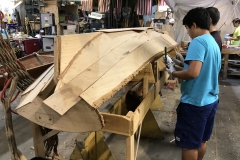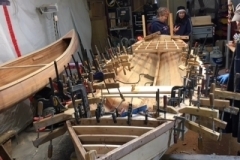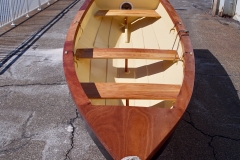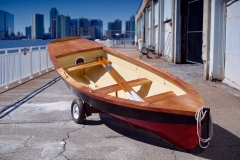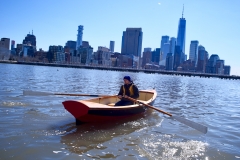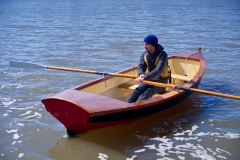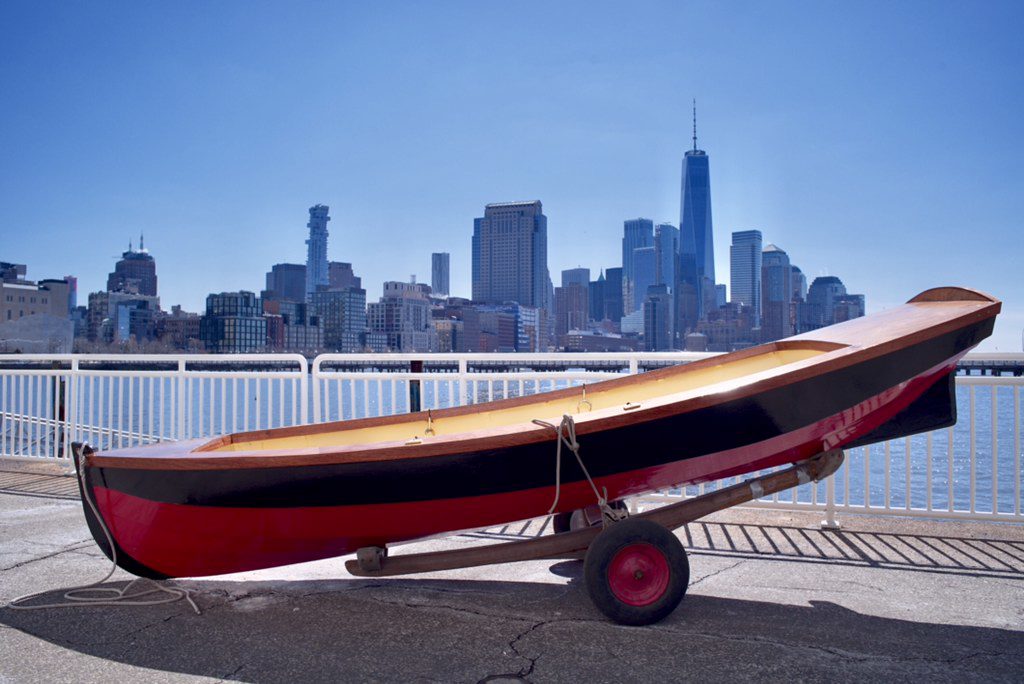 On Sunday, March 11, volunteers from Village Community Boathouse (VCB) launched New York Whitehall B. Banneker from the floating dock on the south side of Pier 40 into the Hudson River. The 13 foot rowboat was mostly built by students working in the basement woodshop of Benjamin Banneker High School for Community Development near the Brooklyn Navy Yard under the direction of VCB boatbuilder Rob Buchanan. Because the stairwell there at the school is so narrow, B. Banneker was removed from the shop after the third plank was on and while she could still be carried up the stairs. Then she was car topped to the VCB shop on pier 40 where community volunteers working with boatbuilder Marcel Dejean added the fourth and final plank, the rails and the decking.
On Sunday, March 11, volunteers from Village Community Boathouse (VCB) launched New York Whitehall B. Banneker from the floating dock on the south side of Pier 40 into the Hudson River. The 13 foot rowboat was mostly built by students working in the basement woodshop of Benjamin Banneker High School for Community Development near the Brooklyn Navy Yard under the direction of VCB boatbuilder Rob Buchanan. Because the stairwell there at the school is so narrow, B. Banneker was removed from the shop after the third plank was on and while she could still be carried up the stairs. Then she was car topped to the VCB shop on pier 40 where community volunteers working with boatbuilder Marcel Dejean added the fourth and final plank, the rails and the decking.
Located in Clinton Hill, about a half mile from the Brooklyn Navy Yard where VCB maintains a floating dock and community rowing program, Banneker High School and VCB were a natural fit. Known for its small family type atmosphere, 90% graduation rate and focus on college admission, Banneker is often referred to as a junior college. The school was named after Benjamin Banneker, a free African American born in 1731, author, surveyor, naturalist, farmer and advisor to Thomas Jefferson. Banneker is best known for his almanacs which included his own astronomical calculations as well as opinion pieces, literature medical information and tide charts. Banneker also published information on bees and calculated the cycle of the 17-year locust.
Whitehalls were specifically designed to handle the New York Harbor chop. The hull shape is characterized by rounded sides, a keel running the entire length of the bottom and a distinctive wine glass transom. The tracking type keel makes this boat design ideal for beginning rowers because it is easier to row in a straight line.
Named after Whitehall Street in lower Manhattan, Whitehalls were dubbed “bicycles of the sea” as they were the most efficient way to get around the city. They served the public as water taxis and fishing boats and could be hired for 25 cents an hour at the foot of Whitehall Street. Whitehalls were also the workboats of the 18th and 19th centuries employed to ferry goods, services, and sailors on and off the ships coming into New York Harbor. Speed was the issue with these boats, as the first to arrive at the ship with the goods generally received the lion’s share of the sales. In 1776, General George Washington evacuated his severely outnumbered troops from the Brooklyn side of the East River in a floatilla of Whitehalls to escape the British in the Battle of Long Island.
Over the last decade VCB has amassed a flotilla of forty traditional rowing craft including six 14 foot New York Whitehalls and eight 25 foot Whitehall Gigs, the stretch version of the shorter New York Whitehall. Most of VCB’s boats were built in conjunction with local school groups and community volunteers. While the 13 foot New York Whitehall B. Banneker can be rowed by one or two rowers, the longer Whitehall Gigs are powered by four rowers and a coxswain who steers and captains the boat. Whitehall Gigs are utilized in VCB’s community and high school rowing programs in New York Harbor while the smaller New York Whitehalls like B. Banneker are better lake boats. Now complete, B. Banneker will join the fleet of small rowing craft at Van Cortlandt Park Lake in the Bronx, where VCB runs a community rowing program on summer Fridays.
Video of the launch of B.Banneker: HERE
Photo by Sebastian Rogers
